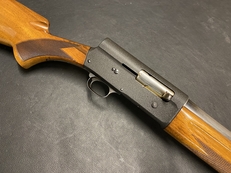
In contrast, German squads were built around a true multipurpose machine gun in Vietnam, the US Army would have its equivalent in the M60. It was too heavy and inaccurate to be a good rifle, but too light, too prone to malfunctions and too difficult to reload to serve as an adequate light machine gun. In the long term, the BAR lacked a proper niche. Even so, with a box magazine mounted underneath the rifle, it was difficult to change the magazine quickly, especially when used as intended from a prone position. In a typical American squad (12 men), two were dedicated to assisting the man with the BAR. The box magazine carried only 20 rounds, so reloading was an operation that needed to be performed regularly. This made accurate fire improbable, but it facilitated suppression fire, and so it served to endear the BAR to the GI all the more. The BAR of World War II permitted only the selection of 350 rpm or 600 rpm. Furthermore, the M1918A2 was designed to fire bursts only, in contrast to the original M1918 that could fire single shots. One reason is the same as that behind its tendency to wear out: its action was very hard on the materials, and the handling of the BAR was correspondingly rough. One of the reasons to use rifle cartridges instead of pistol cartridges (as in submachine guns) is the greater accuracy at range of rifle cartridges, but the BAR failed to capitalize on this advantage. Other limitations included inaccuracy and difficulty in reloading in combat conditions. Fortunately, these same parts were created to facilitate mass production. Much of the new production was needed to replace existing issued weapons. The same lightness of materials that kept the main rifle under 20 lbs (the bipod often being removed by the soldiers for precisely this reason) also ensured that the working parts were subject to considerable wear and tear. When war came again, the M1918A2 was available in numbers, and quickly proved itself in the eyes of the soldiers. While it was unsuited to sustained fire, it was ideal for short bursts of suppression fire, and any tool that visibly helped the GI to survive a little longer on the battlefield was destined for popularity. Each squad was issued one BAR, but the GIs eagerly sought more, and in the last months of the war many squads had two. Before this, it could only be fired like an ordinary rifle, with aimed shots being made from the shoulder or less accurate fire being made from the hip. The bipod was improved in the M1918A2, and the lower surface of the buttstock was altered to keep the rifle upright when not being held. This version offered a bipod, allowing the BAR to be fired like a light machine gun. Refinements were attempted along the way, but the first meaningful change came in 1937, when the M1918A1 was adopted. Still, it was seen as a successful weapon, and it was produced in quantity in the interwar period. The original version, the M1918, was finally issued in the summer of 1918, but only in small quantities, and it played no meaningful part in the end of the war. A limited magazine reduced the weight that the rifleman needed to carry and simplified the rifle’s operation. Much of the weight of a true machine gun in World War I came from its cooling mechanism, and much of the complexity in maintaining it concerned the exchange of barrels when one became too hot.

This was a serious shortcoming for many firefights, but it was also a necessary concession. In practice, it ran out of ammunition long before this its bottom-mounted box magazine only carried 20 rounds. 30 caliber, and its rate of fire could reach 650 rounds per minute in theory. The BAR offered infantry squads short bursts of automatic fire up through rifle distances. Several designs were made to redress this imbalance at least partially machine pistols, such as the Thompson sub-machine gun, were among them. The machine guns of that era did not lend themselves to an infantry attack role, in part because of size and weight and in part because the armies of the period lacked a system for using the machine gun in this way. The technology of the First World War largely favored the defense, and the machine gun in particular posed a severe challenge to attacking troops.

His essential problem was to create a design that would increase the firepower of forces on the attack. The BAR had its limitations, but it was an effective weapon and one that was well-regarded by the soldiers.

Known popularly as the BAR, it was a staple component of every American infantry squad.

The Browning Automatic Rifle was created to breach the stalemate fighting of World War I, but it found its place in the much more varied battlefields of World War II.


 0 kommentar(er)
0 kommentar(er)
